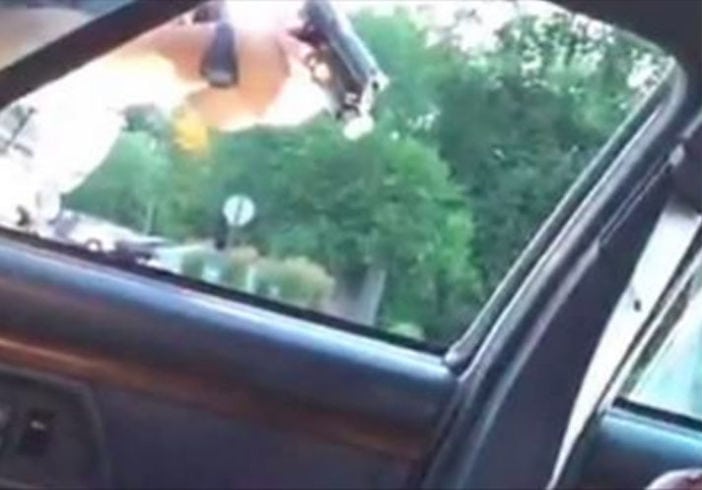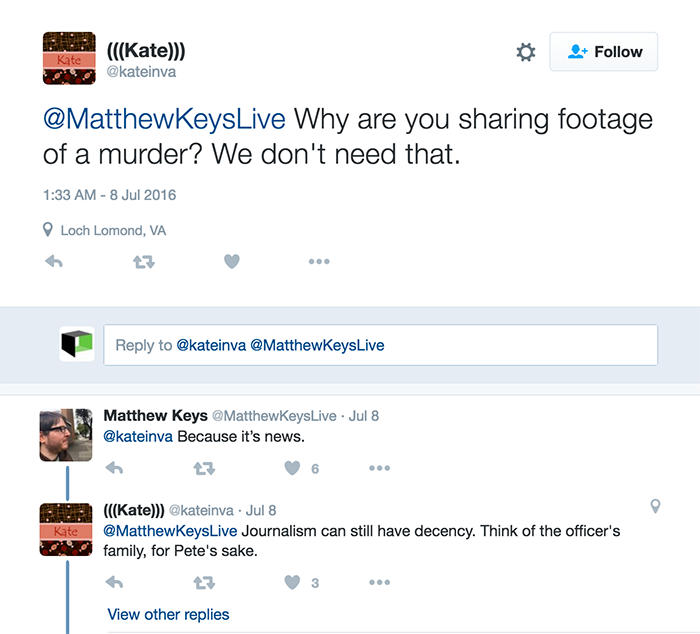Share
Our Great Numbness – 2016’s Images of Violence
In the span of less than a week, we’ve been confronted with the reality of our technology-enabled voyeurism, and are left to contemplate what mea...

In the span of less than a week, we’ve been confronted with the reality of our technology-enabled voyeurism, and are left to contemplate what meaning and role, if any, cameras and their output will play in shaping the dialogue around race, policing, and gun violence.
In Minnesota, police fired multiple shots while subduing 37-year old Alton Sterling. At least two cellphone videos have emerged of the killing. Police allegedly obtained security cam footage from the deli as well, while two police body cameras became “dislodged.”
A day later, police shot and killed 32-year old school cafeteria worker Philando Castile during a traffic stop. His girlfriend, Diamond Reynolds broadcasted from her phone using Facebook Live in the immediate aftermath, streaming Castile’s slumped body and her apprehension by police.
And two days after Castile’s death, Micah Johnson killed 5 policemen during a Black Lives Matter protest in Dallas. Much of the mayhem and at least one execution-style assault was captured and streamed in realtime by bystanders at the scene.
KDFW shows disturbing footage showing one Dallas shooting suspect firing on unknown individual pic.twitter.com/jlyeaaNiKH
— Matthew Keys (@MatthewKeysLive) July 8, 2016
Each video in and of itself is shocking for its brutality and violence. Watching a person being killed at point blank range is a sobering and disturbing experience. On face value, each video should be enough to stimulate discussion and reaction around the circumstances that lead to death. But will they?
It’s too early to tell. Events are still unfolding around us, but one can’t deny the possibility that the barrage of violent and thought-provoking imagery has given way to a collective numbness. The dialogs that have emerged are largely polarized. We can’t even agree whether we should be watching in the first place.

ZEITGEIST & IMAGES
Can images influence the mood and direction of history? Has the influence of the image waned as they’ve become more commonplace?
In 1955, a black 14-year old teen, Emmitt Till, was severely beaten and lynched by two white men after allegedly “wolf whisting” at a white cashier. Till’s mother insisted on an open casket funeral so that the public could witness the viciousness unleashed upon her child. Photos that ran in Jet magazine and The Public Defender raised the public’s ire and recast the perception of the murderers. Civil rights pioneer Rosa Parks credits Till’s murder for her refusal to give up her seat on a bus saying, “I thought of Emmett Till and I just couldn’t go back.”
Till’s photos are still shocking, and arguably would never be run today in any major news outlet. A child’s battered face doesn’t meet western society’s standard of decency.
The body of 3-year old Syrian refugee Aylan Kurdi facedown on the beach ironically did meet the standard of decency and was plastered on the front pages of newspapers and websites around the world. Pundits hoped the image would dramatically alter the immigration policies of western Europe and the US, but the change was short-lived. The war continues, and refugees are still dying by the hundreds.

The value of Kurdi’s image is diminished the longer things remain the same. A symbol holds its value in being unique, but when refugee children continue to die in droves, the symbol becomes a commodity – a cheap tourist trinket on a Turkish beach.
SHOCKING IMAGES NO MORE
Renown photojournalist Christopher Morris recently commented at the Look3 Festival in Charlottesville, VA that “It is rare to shock people into sensibility” lamenting the attenuated influence that photos and video have in an image saturated world.
Award-winning photojournalist Mary F. Calvert believes that photos are only a part of a given movement. “Gay marriage didn’t happen because of one person [or one photo] – it was a groundswell [of activity].” Images have become language, and that language supports broader movements. But the image itself is not the thesis.
In seeing these images, our reaction is tempered by what we expect as an outcome. When Spanish matador Victor Barrio was viciously gored and killed, the initial shock didn’t lead to calls for a referendum on bullfighting. Spaniards accept a certain level of risk with this cultural pastime. Some detractors even said he had it coming.
https://twitter.com/reevo3000/status/751910029394055169
A tragic death, but the images won’t be a catalyst for change because Spanish society accepts its inevitability.
A SNUFF FILM SOCIETY
My college roommate Rhasaan Manning (and my first black friend as a kid coming from Hawai’i), recently wrote the following missive on Facebook:
“We have to be aware in our outrage, frustration, and anger that we are becoming a snuff film society. These documents of transgression are available and vital as proof, though up until now they have not yielded justice, and they have a cost. I suspicion that in none of these circumstances did the person recording imagine that the person who was under siege was about to die. In the aftermath of loop replays the shock dwindles. Herein lies the danger for each individual who absorbs death in such volume. We have to protect our hearts while informing our minds. I can not watch, though I continue to read.”
We are told not to watch, but can we resist? Will the videos of Eric Garner, Tamir Rice, Sandra Bland, Alton Sterling, Philando Castile and others ultimately lead to reforms, or are we simply self-inducing PTSD?
Writer Damon Young compares the barrage of violent imagery to Bill Murray’s Groundhog Day:
“Today, however, when thinking about the murder of Alton Sterling, I don’t feel sad. Or mad. Or…anything. I’m sure I will eventually. Rather, I hope I will. But right now, my prevailing feeling exists somewhere between exhaustion and Groundhog Day. Like I’m playing a game I’m tired of playing but need to continue playing because everyone else at the party is playing and they need me to keep playing to keep the teams even.”
A POLARIZED LENS
Part of the problem is that we can’t agree to what we’re seeing. In the Sterling case, some people see police apprehending a felon with a long rap sheet and in possession of an illegal firearm. Others see a brutal execution protected under a wall of blue chanting the oft-heard mantra “I feared for my life.” It’s a continued reminder that there is no objective reality in photos/video or otherwise. We perceive what our experiences and biases tell us to perceive – arguably more so than in the past when a child’s pummeled face actually could influence a national dialog and spark change.
How tragic to wish for the good ‘ole days.


